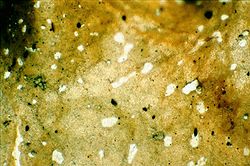
Pseudocyphellae (singular pseudocyphella) are structures in lichens that appear as tiny pores on the outer surface (the cortex) of the lichen. They are caused when there is a break in the cortex of the lichen, and the medullary hyphae extend to the surface. Pseudocyphellae are the same colour as the medulla of the lichen, which is generally white, but can be yellow in some species of Pseudocyphellaria and in Bryoria fremontii. The presence/absence, abundance, colour, and shape of pseudocyphellae can all be diagnostic features used to identify different species. They facilitate gas exchange through the surface of the lichen, and may provide an adaptive advantage in temperate environments.

References
- Brodo, I. M., S. D. Sharnoff, and S. Sharnoff. 2001. Lichens of North America. Yale University Press: New Haven.
- Hale, Mason E. (1981). "Pseudocyphellae and pored epicortex in the Parmeliaceae: Their delimitation and evolutionary significance". The Lichenologist. 13 (1): 1–10. doi:10.1017/S0024282981000030. S2CID 86327477.